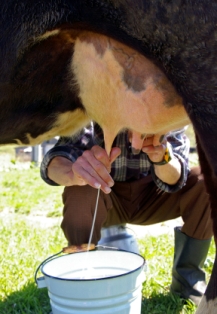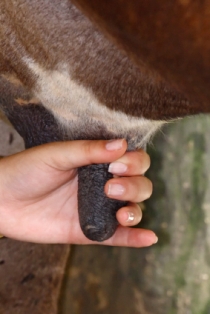Keeping livestock for milk is one of the oldest and most traditional ways of self-sufficient farming and it is still a way of ensuring food security today. Many types of livestock – including sheep, goats and cattle – can be kept to supply milk.
If you would like regular, plentiful supplies of fresh milk daily, with excesses available to produce products like cheese and butter, a dairy cow is your best choice.
How much milk does a cow produce?
For a cow to produce milk she will need to be mated 9 months prior in order to give birth to a calf. When she has calved, milk production will continue for up to 10 months. At that point, she should be ‘dried off’ in preparation for her next calving two months later. On average, a milking cow will produce between 35-50 litres of milk each day, with the daily amount decreasing as the season progresses.
Milking routine
Milking a cow is a big commitment. Routine is important, so try to milk each day at around the same time, ideally at 12 hour intervals. The simplest system for those with a 9-to-5 job is to milk your cow once a day and keep the ‘calf at foot’. The calf should be separated from its mother in the morning for the late afternoon's milking to ensure you 'get your share' of the day’s production. Once the cow is milked, the calf can be reunited with its mother for overnight grazing.
When milking once a day, the calf will require additional feed supplements (calf pellets) plus daily access to fresh pasture, hay and water during the period when it is separated from its mother.
 |
How to milk a cow?
Hand milking is the traditional method of getting milk from a cow. To be successful, it requires an efficient method and a patient approach.
Basic steps of hand milking
Step 1 – Lead the cow into the milking stall. Have a mixed ration of grain or quality hay ready and waiting.
Step 2 – Check the teats. If they are visible dirty, wash the udder with clean water. Cow teats are otherwise surprisingly hygienic. Dry each teat, especially the teat tips. Applying water unnecessarily increases the risk of an udder infection (mastitis).
A cow will normally let down her milk by the time milking is ready to commence, with udder massaging often unnecessary. Milk let-down typically lasts for 10 minutes so try to complete the process within this period.
Step 3 – Squirt the first milk from each teat into a cup to check for blood or lumps. This may indicate mastitis, so if you find this, do not consume the milk.
Step 4 – Place a sterile milking pale slightly in front of the udder and take a seat. A plastic crate or squat wooden stool is ideal.
Step 5 – Wrap the thumb and forefinger around the top of the teat to trap the milk, then slowly squeeze (don’t pull) the teat, bringing in each other finger one at a time in a smooth sequential rolling action, forcing the milk out. Rotate from one teat to the other allowing each to refill.
Step 6 – Once the milk stops, dip or spray each teat with an iodine based teat sanitiser before releasing the cow.
 |
Machine milking
If hand milking all sounds a bit much, there is always the option of machine milking. Benefits of machine milking include the speed at which milking gets done, improved milking routines (no delays) and enhanced milk let-down due to the pulsation of the machine.
There are mobile milking machines suited to hobby farms that run on 240 volt power. These machines are capable of milking up to six cows an hour or fifteen goats. Dairy Maid Milking Equipment supplies these machines which cost approximately $1500.
Cattle breeds and cow selection
The most popular dairy cows used for home milking are the Jersey or Guernsey. If you don’t need much milk, or if you are concerned about handling a normal sized cow, small cattle breeds like the miniature Galloway are a worthy alternative.
The most popular dairy cows used for home milking are the Jersey or Guernsey. If you don’t need much milk, or if you are concerned about handling a normal sized cow, small cattle breeds like the miniature Galloway are a worthy alternative.
Selecting and trying to milk a cow that is not accustomed to hand milking, e.g. direct from a farmer’s herd, is a dangerous option. As a first time milker, you should locate a cow that is broken in, i.e. one that is quiet and able to be led by a halter.
Handling your cow
First time milkers should use a milking stall, which will protect both the milker and the cow until she becomes familiar with the process.
While milking, talk calmly and regularly to your cow and let her know your whereabouts by stroking and patting her. A cow should want to be milked, and if she is unsettled, something is usually wrong. Don’t lose your temper. If necessary, walk away and try again later; this won’t hurt her.
In time, any cow will become very friendly, even affectionate, and will certainly want to be milked. Milking time will then be something for both of you to enjoy.
Where to from here?
For further information on self-sufficient farming and how to milk a cow, we recommend you purchase a copy of Dairy Agskills. This book provides information on breeding, feeding, animal welfare and managing calving cows.
About the author
The author Charlie Roberts is one of the FarmStyle Australia experts, he runs this website and has a Bachelor of Farm Management and a Masters of Business Administration. He has worked for a number of agricultural companies in both New Zealand and Australia. He has a wealth of experience working with farmers in a range of environments.



